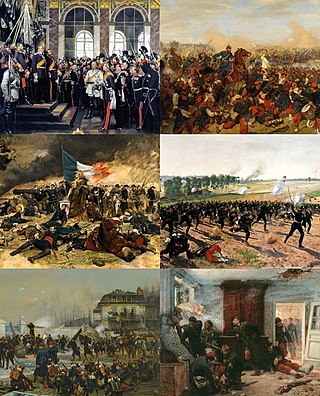
The Franco-Prussian War or Franco-German War, often referred to in France as the War of 1870, was a conflict between the Second French Empire and the North German Confederation led by the Kingdom of Prussia. Lasting from 19 July 1870 to 28 January 1871, the conflict was caused primarily by France's determination to reassert its dominant position in continental Europe, which appeared in question following the decisive Prussian victory over Austria in 1866. According to some historians, Prussian chancellor Otto von Bismarck deliberately provoked the French into declaring war on Prussia in order to induce four independent southern German states—Baden, Württemberg, Bavaria and Hesse-Darmstadt—to join the North German Confederation; other historians contend that Bismarck exploited the circumstances as they unfolded. All agree that Bismarck recognized the potential for new German alliances, given the situation as a whole.
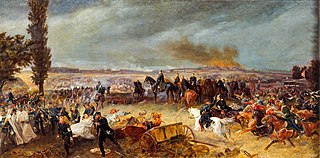
The Battle of Königgrätz was the decisive battle of the Austro-Prussian War in which the Kingdom of Prussia defeated the Austrian Empire. It took place on 3 July 1866, near the Bohemian city of Hradec Králové and village of Sadová, now in the Czech Republic. It was the single largest battle of the war, and the largest battle in the world since the Battle of Leipzig in 1813.
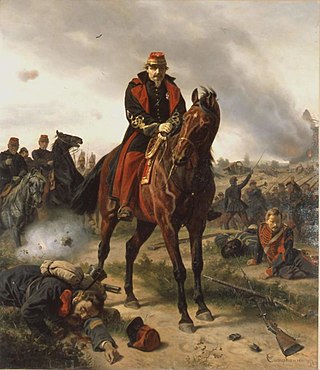
The Battle of Sedan was fought during the Franco-Prussian War from 1 to 2 September 1870. Resulting in the capture of Emperor Napoleon III and over a hundred thousand troops, it effectively decided the war in favour of Prussia and its allies, though fighting continued under a new French government.
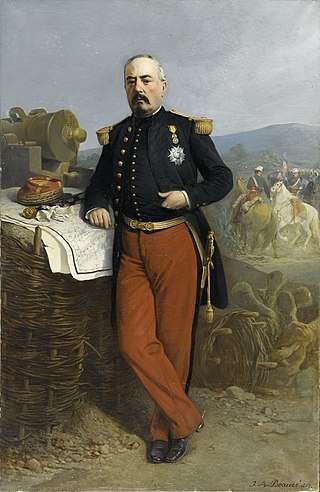
François Achille Bazaine was an officer of the French army. Rising from the ranks, during four decades of distinguished service under Louis-Philippe and then Napoleon III, he held every rank in the army from fusilier to Marshal of France, the latter in 1863.

The Battle of Gravelotte on 18 August 1870 was the largest battle of the Franco-Prussian War. Named after Gravelotte, a village in Lorraine, it was fought about 6 miles (9.7 km) west of Metz, where on the previous day, having intercepted the French army's retreat to the west at the Battle of Mars-la-Tour, the Prussians were now closing in to complete the destruction of the French forces.

The siege of Metz was a battle fought during the Franco-Prussian War from August 19 to October 27, 1870 and ended in a decisive allied German victory.

The Battle of Wissembourg or Battle of Weissenburg, the first of the Franco-Prussian War, was joined when three German army corps surprised the small French garrison at Wissembourg on 4 August 1870. The defenders, greatly outnumbered, fought stubbornly "especially considering they were surprised and greatly outnumbered, that the French sustained their old renown as fighting men and that the first defeat, although severe, reflected no discredit on the soldiers of the 1st Corps." The fall of Wissembourg allowed the Prussian army to move into France and compelled Marshal Patrice MacMahon to give battle, and suffer defeat, at the Battle of Wörth on 6 August.

The Battle of Spicheren, also known as the Battle of Forbach, was a battle during the Franco-Prussian War. The German victory compelled the French to withdraw to the defenses of Metz. The Battle of Spicheren, on 6 August, was the second of three critical French defeats. General Helmuth von Moltke had originally planned to keep Bazaine's army on the Saar river until he could attack it with the 2nd Army in front and the 1st Army on its left flank, while the 3rd Army closed towards the rear. The aging General von Steinmetz made an overzealous, unplanned move, leading the 1st Army south from his position on the Moselle. He moved straight toward the town of Spicheren, cutting off Prince Frederick Charles from his forward cavalry units in the process.

The Battle of Mars-la-Tour was fought on 16 August 1870, during the Franco-Prussian War, near the village of Mars-La-Tour in northeast France. One Prussian corps, reinforced by two more later in the day, encountered the entire French Army of the Rhine in a meeting engagement and, following the course of battle, the Army of the Rhine retreated toward the fortress of Metz.
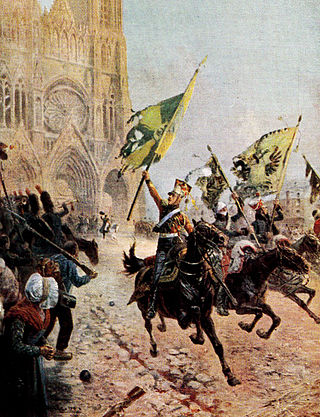
The Battle of Reims was fought at Reims, France between an Imperial French army commanded by Emperor Napoleon and a combined Russian-Prussian corps led by General Emmanuel de Saint-Priest. On the first day, Saint-Priest's Russians and General Friedrich Wilhelm von Jagow's Prussians easily captured Reims from its French National Guard garrison, capturing or killing more than half of its defenders. On the second day, an overconfident Saint-Priest carelessly deployed his forces west of the city, not grasping that Napoleon was approaching with 20,000 troops. Too late, Saint-Priest realized who he was fighting and tried to organize a retreat. In the battle that followed, the French army struck with crushing force and the Allies were routed with serious losses. During the fighting, Saint-Priest was struck by a howitzer shell and died two weeks later.
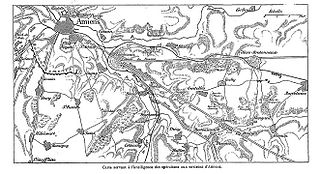
The Battle of Amiens, also known as the Battle of Villers-Bretonneux, was fought on 27 November 1870 between French and Prussian forces during the Franco-Prussian War (1870–1871). It ended in a Prussian victory, forcing the French to retreat and allowing the Prussians to capture Amiens, France.
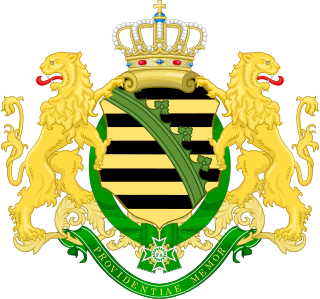
The Royal Saxon Army was the military force of the Electorate (1682–1807) and later the Kingdom of Saxony (1807–1918). A regular Saxon army was first established in 1682 and it continued to exist until the abolition of the German monarchies in 1918. With the formation of the Confederation of the Rhine by Napoleon the Royal Saxon Army joined the French "Grande Armée" along with 37 other German states.
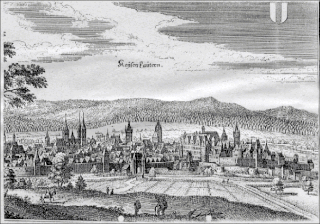
The Battle of Kaiserslautern saw a Coalition army under Charles William Ferdinand, Duke of Brunswick-Wolfenbüttel oppose a Republican French army led by Lazare Hoche. Three days of conflict resulted in a victory by the Prussians and their Electoral Saxon allies as they turned back repeated French attacks. The War of the First Coalition combat was fought near the city of Kaiserslautern in the modern-day state of Rhineland-Palatinate, Germany, which is located about 60 kilometres (37 mi) west of Mannheim.

The Army of Châlons was a French military formation that fought during the Franco-Prussian War of 1870. Formed in the camp of Châlons on August 17, 1870, from elements of the Army of the Rhine which the formation was issued from, the Army of Châlons was engaged in combats of Beaumont and Sedan while disappearing during the capitulation of September 2, 1870.

The Army of the Rhine was a French military unit that fought in the Franco-Prussian War. It was created after the declaration of war on July 18 1870.
The Battle of Nouart was fought on 29 August 1870 at the village of Nouart. Part of the Franco-Prussian War of 1870–1871, the battle saw Prince George's 46th Infantry Brigade of the XII Royal Saxony Corps defeat Pierre Louis Charles de Failly's V Corps of the French Empire.
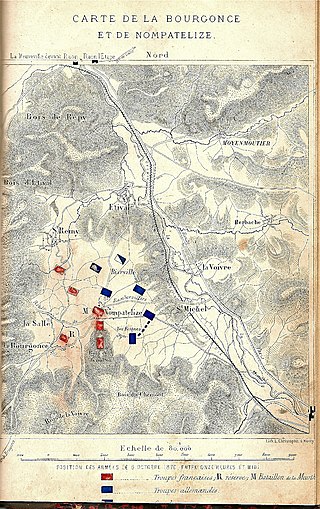
The Battle of Nompatelize, also known as the Battle of Etival, was a battle of the Franco-Prussian War on 6 October 1870, between Etival and Nompatelize in the province of Vosges from Strasbourg 64 km southwest. This battle marked the first major crackdown of franc-tireur operations in the Vosges region by the XIV Corps of the Prussians by Minister August von Werder in early October 1870. In matches fiercely this, A force of the Army of Rhône of the French Republic under the command of General Louis-François Dupré, who predominated to markedly document in terms of troop numbers, and attacked 6 infantry battalions of the Grand Duchy of Baden under the command of General Alfred von Degenfeld which were part of the XIV Corps, but were defeated. Compared to the casualties of the German military, the losses of the French side in this battle were much greater. After seven hours of fighting, the French were forced to flee in turmoil to Bruyeres and the Rambervillers. The Battle of Etival contributed to General Werder wiping out the French from Alsace.

The Battle of Artenay' also known as the Battle of Arthenay, took place during the Franco-Prussian War, on October 10, 1870, in Artenay a small town located on the road from Orléans to Paris, France which was about 10 miles north of the city of Orléans. In this fierce battle, with superior strength compared to the opponent, The I Corps of the Kingdom of Bavaria, under the command of Lieutenant General Ludwig von der Tann-Rathsamhausen, in collaboration with the 22nd Division of the XI Corps of the Kingdom of Prussia and the two cavalry divisions of the Prussian army attacked and penetrated the defense system of the army of the Loire of the young French Republic, under the control of general Joseph Edouard de la Motterouge, causing heavy losses for the French military of which many people were taken prisoner. The winning conditions Artenay were favorable enough for Von der Tann to strike Orléans, while the forces of France knocked back on Orléans forest in an agitated state. Despite this, Nièvre's Garde Mobiles and the Pontifical Legion in the French army were noted for their strong resistance, while a monk in Prussian Cavalry under the command of Prince Albrecht demonstrated his prowess in the battle at Artenay.
The Fighting in Fréteval was a battle in the Franco-Prussian War, it occurred in December 14 — 15, 1870, near the village of Fréteval of France. In this fierce engagement, a corps of the Prussian army under the command of Friedrich Franz II, Grand Duke of Mecklenburg-Schwerin contested Fréteval with a force of the French army 's Loire Corps under General Antoine Chanzy, but neither side was able to seize the advantage. The battle demonstrated the effective combat capabilities of Chanzy's forces, with a huge numerical superiority over Mecklenburg's forces. From 15 December, however, Mecklenburg's army was reinforced on the left, and in light of that situation Chanzy finally made a retreat to Le Mans.
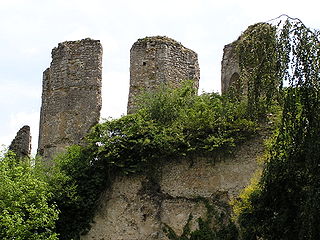
The Battle of Vendôme took place during the Franco-Prussian War, it lasted from December 14–17, 1870 in Vendôme, Loir-et-Cher, France. In this fierce fighting, the X Army of the Kingdom of Prussia under the command of General Konstantin Bernhard von Voigts-Rhetz and the 2nd Army of Prussia which was commanded by Prince Friedrich Karl, attacked the French Army of the Loire by Minister Antoine Chanzy and Admiral Bernard Jaureguiberry who was a former navy officer of France. The Prussians defeated the French in a gun battle on December 16 and finally won the battle. With this victory, the Germans attacked the enemy's right flank and forced the French forces to withdraw from their stronger defensive position at Fréteval, where they engaged another Prussian army indecisively. The victory at Vendôme also brought the Prussian armies some French prisoners and weapons, while the disadvantage of Chanzy's army forced him to hastily withdraw to Le Mans.

















